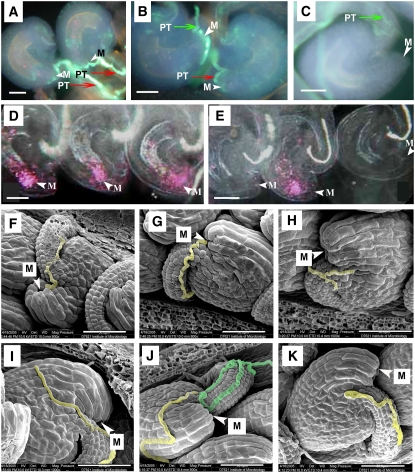Figure 2.
Pollen Tube Guidance in Wild-Type and ccg/CCG Plants.
(A) to (C) Ovules stained with aniline blue to visualize the pollen tube (PT). M, micropyle.
(D) and (E) Whole-mount stained ovules pollinated with pollen grains carrying the ProAKV:GUS reporter.
(F) to (K) Scanning electron micrographs showing pollen tube guidance; the pollen tubes were false-colored with blue or yellow.
(A) An example of pollen tube (arrow) entry into the micropyle (arrowhead) in wild-type pistils.
(B) A micrograph showing two ovules in mutant pistils (ccg/CCG). Note pollen tube entry into the ovule at the right as in (A) but into the ovule at the left.
(C) A micrograph showing a mutant ovule without pollen tube in the same pistil as in (B). Note that the pollen tube grows along the funiculus and turns back at the micropyle region.
(D) A micrograph showing that all ovules in wild-type pistils had GUS activity carried by the pollen tube at the micropylar part of the embryo sacs (arrowheads), indicating successful pollen tube entry.
(E) A micrograph showing that in mutant pistils (ccg/CCG), approximately half of the ovules had no GUS activity, indicating no pollen tube entry.
(F) and (G) Scanning electron micrograph of wild-type ovules showing that pollen tubes grow along the funiculus and then turn abruptly to enter the micropyle (arrowheads).
(H) to (K) Aberrant pollen tube guidance in ccg ovules.
(H) A pollen tube stops growing near the micropyle (arrowhead).
(I) A pollen tube bypassing the micrpopyle and growing on the surface of the integument.
(J) Two pollen tubes grow along the funiculus but fail to enter the micropyle (arrowhead). One pollen tube bypasses the micropyle (yellow), and another pollen tube (blue) turns away from the micropyle.
(K) Another example showing that the pollen tube turns away from the micropyle.
Red arrow indicates pollen tube entry into the micropyle; green arrow indicates no pollen tube entry. Bar = 20 μm for (A) to (E) and 50 μm for (F) to (K).

